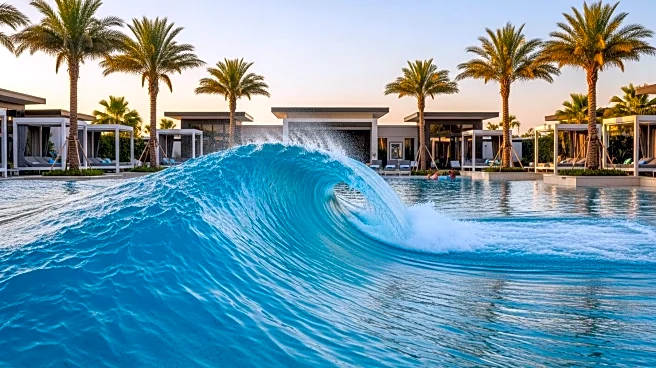What's Happening?
Surf Abu Dhabi has launched the world's longest artificial wave pool, aiming to transform Abu Dhabi into a premier global surfing destination. The pool, which opened in October 2024, spans 755 yards and offers rides lasting up to a minute. Utilizing technology developed by Kelly Slater, the pool features a patented bathymetry that creates consistent waves. The facility targets the luxury travel market, with prices reaching AED20,000 for private sessions. The pool's design allows only four surfers at a time, ensuring exclusivity and quality over quantity. The global surf tourism industry, valued at $68.3 billion in 2024, is projected to grow to $95.93 billion by 2030, and Surf Abu Dhabi aims to capture a significant portion of this market.
Why It's Important?
The opening of Surf Abu Dhabi represents a significant shift in the surf tourism industry, emphasizing luxury and exclusivity. By offering a controlled environment, the pool attracts high-net-worth individuals and professionals who may not have the time or inclination to chase natural waves. This development could redefine surfing as a mainstream sport, similar to golf, appealing to affluent clients seeking unique experiences. The pool's success could influence the construction of similar facilities worldwide, potentially altering the dynamics of surf tourism and expanding the sport's reach beyond traditional coastal areas.
What's Next?
Surf Abu Dhabi's focus on luxury and exclusivity may lead to increased interest from international visitors, further boosting Abu Dhabi's reputation as a luxury travel destination. The facility's success could prompt the development of additional wave pools globally, utilizing similar technology. As the industry grows, there may be increased competition among luxury surf destinations, driving innovation and potentially lowering costs for consumers. The pool's impact on local tourism and economy will be closely monitored, with potential expansions or collaborations with other luxury brands.
Beyond the Headlines
The rise of artificial wave pools raises questions about the environmental impact and sustainability of such facilities. While they offer controlled and consistent conditions, they may lack the natural connection to the ocean that traditional surfing provides. Additionally, the exclusivity and high cost of access could limit participation to affluent individuals, potentially widening the gap between different socioeconomic groups in the sport. The cultural implications of commodifying surfing, traditionally seen as a countercultural activity, may also be explored as the industry evolves.

